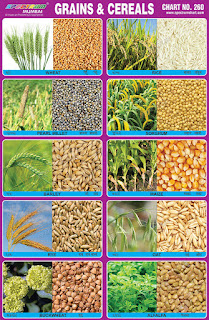 |
| Grains & Cereals Chart |
Spectrum Chart - 260 : Grains & Cereals
1. Wheat - Wheat is a cereal grain that
people can eat. It is a kind of grass whose fruit is a "head of
wheat" with edible seeds. wheat is the leading source of
vegetable protein in human food. Wheat grain is a staple food used to
make flour for leavened, flat and steamed breads, biscuits, cookies,
cakes, breakfast cereal, pasta, noodles etc. China & India are
the leading producer of the wheat in the world.
2. Rice - Rice is a type of grain. It is
eaten as staple food in many parts of Asia. Rice used to be the main
diet in many countries. It is usually eaten cooked or boiled. China &
India are the leading producer of rice in the world. Rice production
comprises 42% of the overall food crop production in India.
3. Pearl Millet - Pearl millet is the most
widely grown type of millet. It has been grown in Africa and the
Indian subcontinent since prehistoric times. Pearl millet is well
adapted to growing areas characterised by drought, low soil
fertility, and high temperature. It performs well in soils with high
salinity. Because of its tolerance to difficult growing conditions,
it can be grown in areas where other cereal crops would not survive.
It accounts for approximately 50% of the total world production of
millets.
4. Sorghum – Soghum plants are used for
grain, fibre and fodder. The plants are cultivated in warmer climates
worldwide. Sorghum species are native to tropical and subtropical
regions of Africa and Asia. Countries such as India predominantly use
sorghum as a fodder for poultry and cattle. Sorghum is used for food,
fodder and the production of alcoholic beverages. It is drought
tolerant and heat tolerant and is especially important in arid
regions. It is an important food crop in Africa, Central America and
South Asia and is the fifth most important cereal crop grown in the
world.
5. Barley - Barley is a major cereal grain
grown in temperate climates globally. It was one of the first
cultivated grains. Barley has also been used as animal fodder. Barley
is
a key ingredient in beer and whisky production. Russia is the world's
largest producer of barley.
6. Maize - Maize, commonly known as corn,
is a large grain plant first domesticated by indigenous peoples in
Mexico about 10,000 years ago. The six major types of corn are dent
corn, flint corn, pod corn, popcorn, flour corn and sweet corn. It is
used as a staple food by many people in Mexico, Central and South
America and parts of Africa. USA is the leading producer of maize in
the world.
7. Rye – Rye is a grass grown
extensively as a grain, a cover crop and as a forage crop. It is a
member of the wheat tribe. Rye grain is used for flour, rye bread,
rye beer, crisp bread, some whiskeys, some vodkas and animal fodder.
It can also be eaten whole, either as boiled rye berries or by being
rolled, similar to rolled oats.
8. Oat – Oat is a species of cereal
grain grown for its seed. Oats are suitable for human consumption as
oatmeal and rolled oats are used as livestock feed. Oats are best
grown in temperate regions. They have a lower summer heat requirement
and greater tolerance of rain than other cereals, so they are
particularly important in areas with cool & wet summers. Oats are
generally considered healthy due to their rich content of several
essential nutrients. The established property of their
cholesterol-lowering effects has led to acceptance of oats as a
health food.
9. Buckwheat – Buckwheat is a plant
cultivated for its grain-like seeds and also used as a cover crop. In
India, on Hindu fasting days, fasting people in northern states of
India eat items made of buckwheat flour.
10. Alfalfa - Alfalfa also called lucerne,
is a perennial flowering plant in the pea family Fabaceae cultivated
as an important forage crop in many countries around the world. It is
used for grazing, hay and silage. The name alfalfa is used in North
America. The name lucerne is the more commonly used name in the U.K.,
South Africa, Australia and New Zealand. Alfalfa is native to warmer
temperate climates. It has been cultivated as livestock fodder.

No comments:
Post a Comment